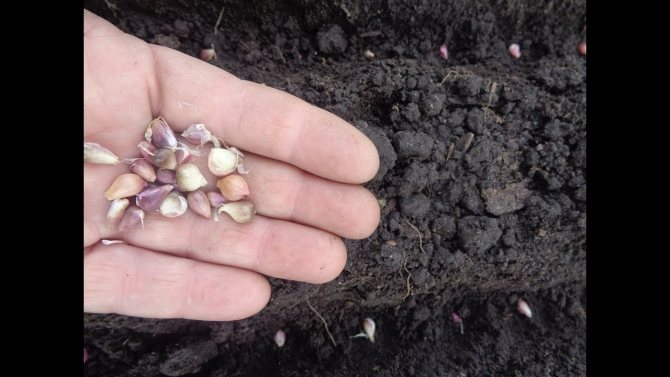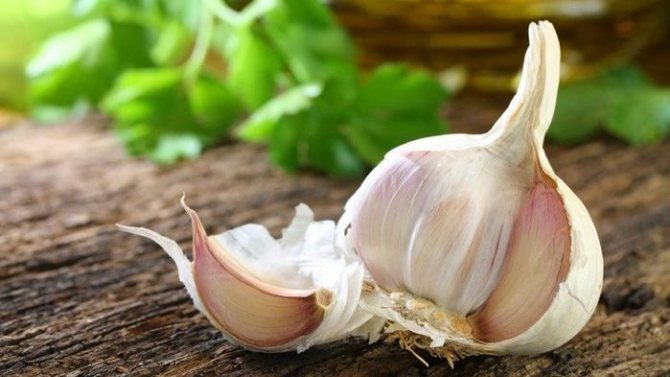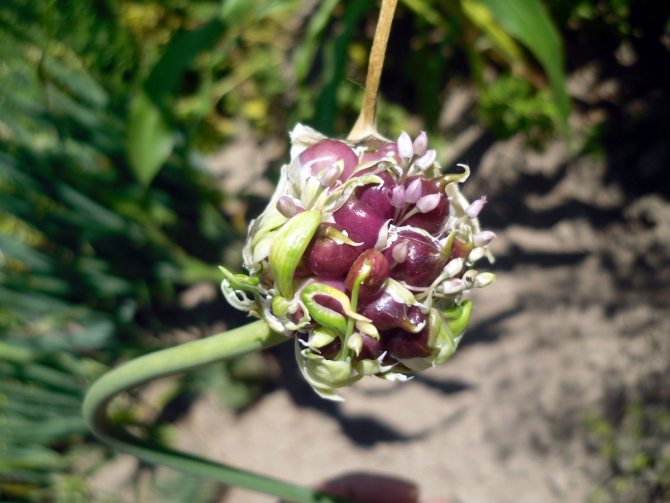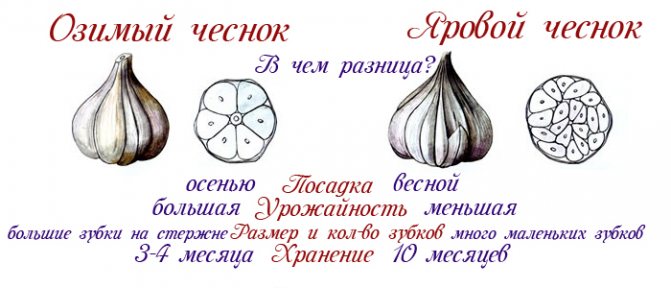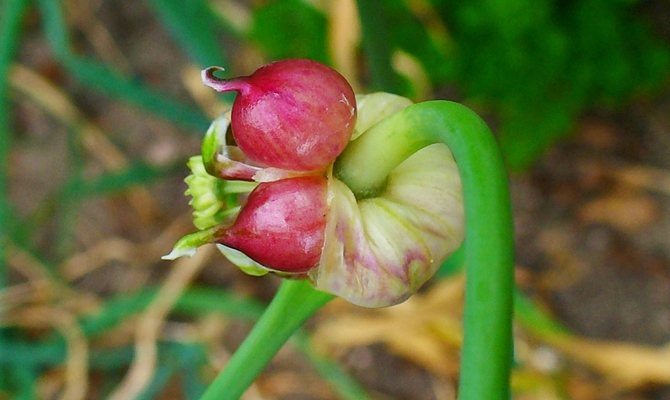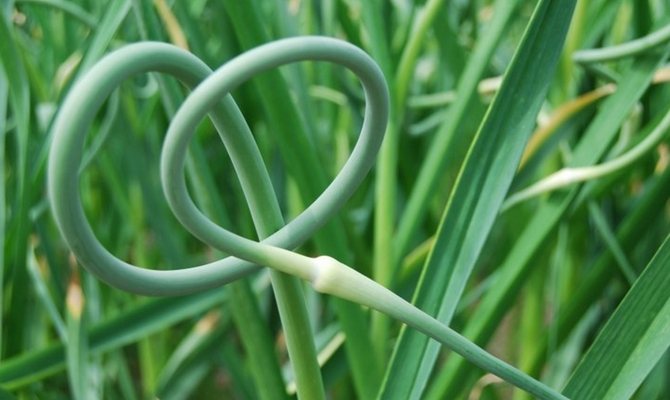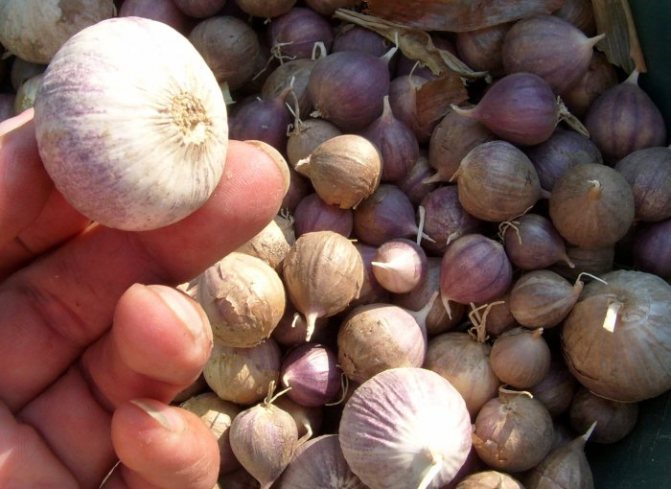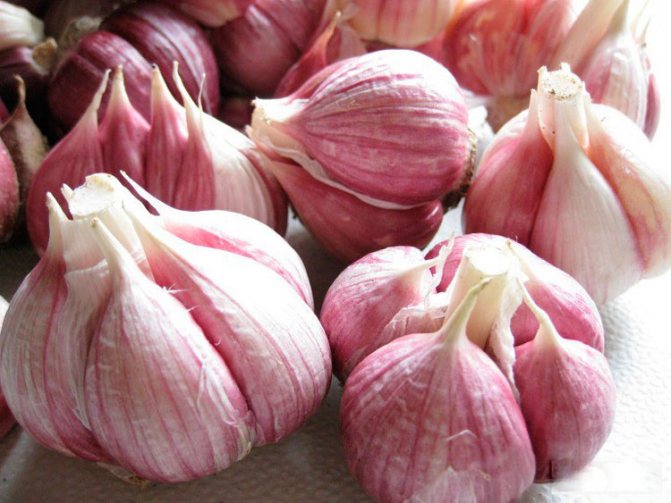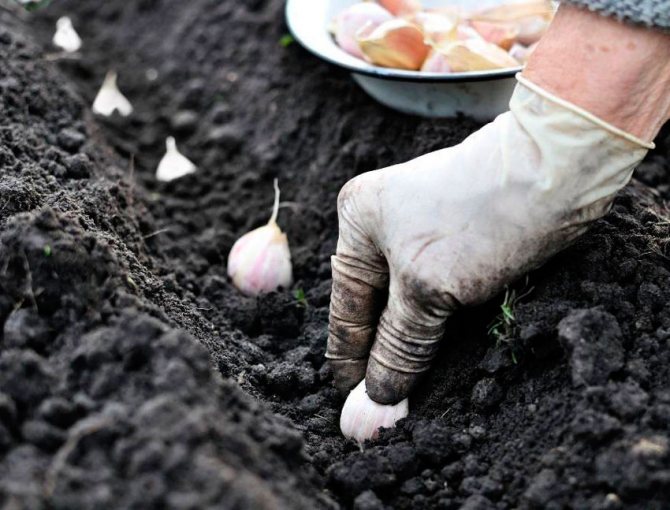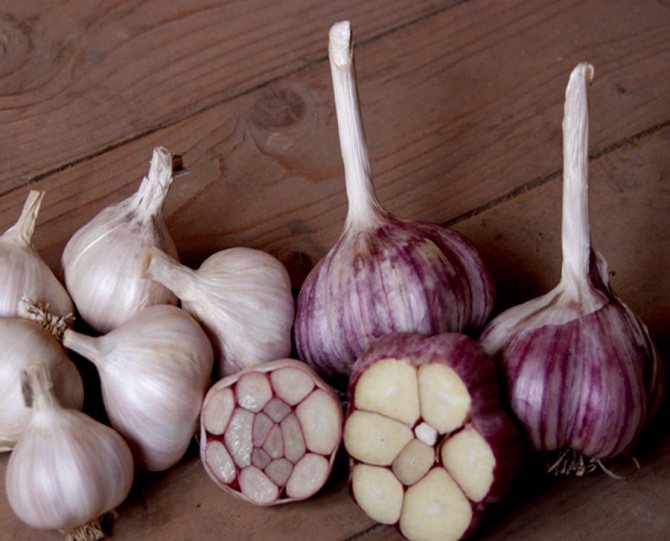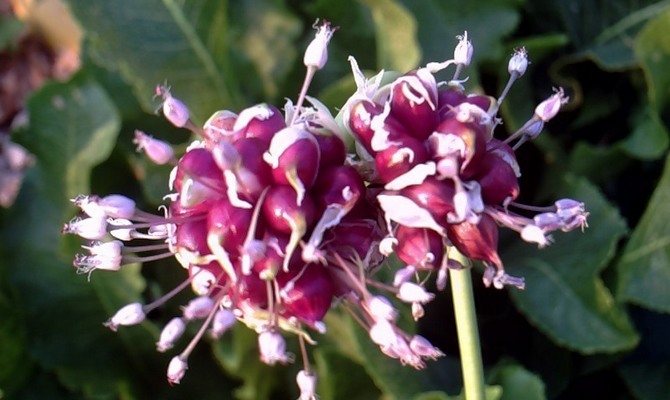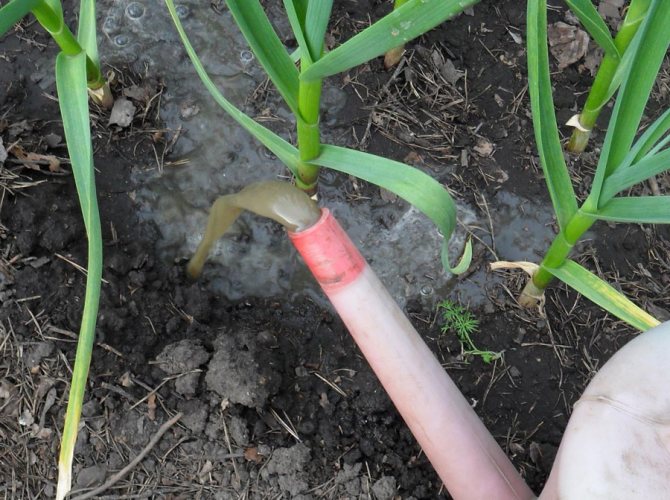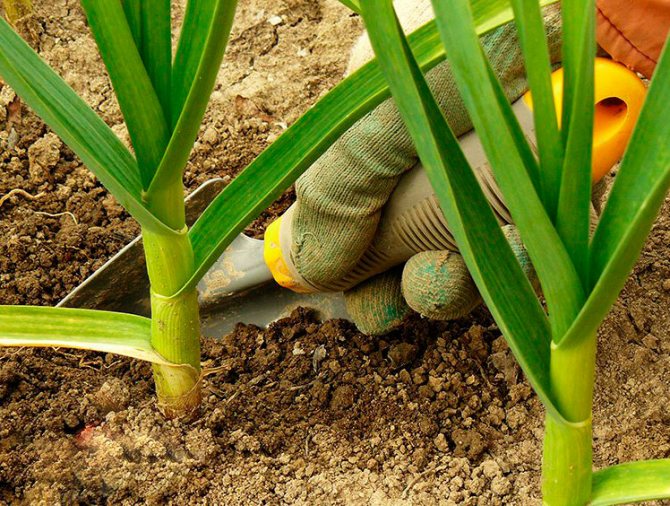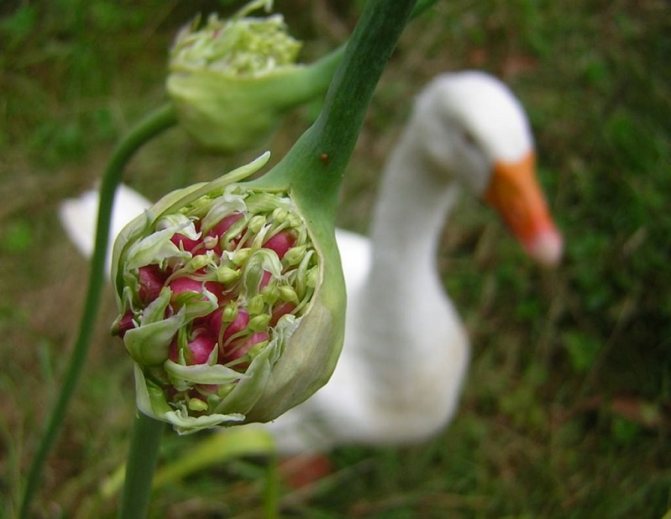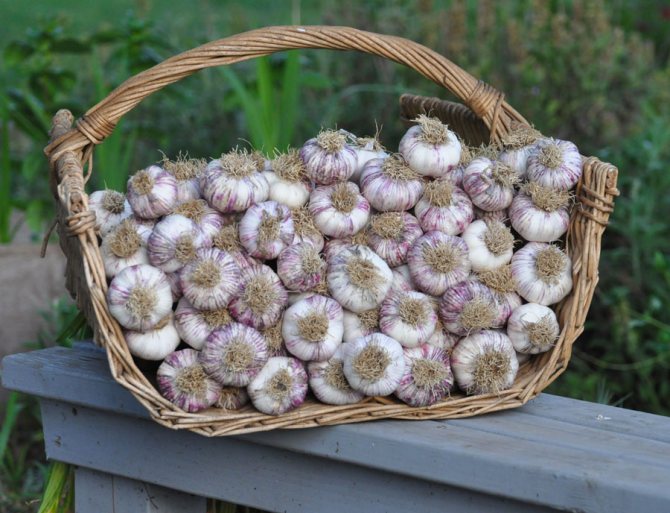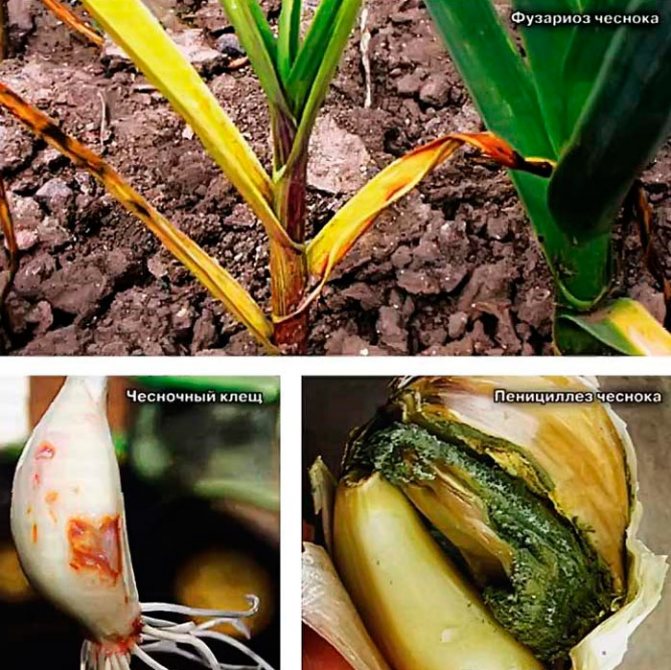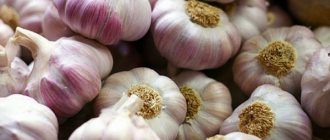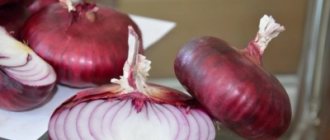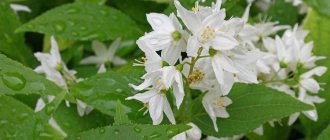Specific features of garlic
Garlic belongs to the herbaceous plants of the bulbous family. It has a round bulb with a fibrous rhizome. The leaves are narrow, lanceolate, 30 to 90 centimeters long, growing from each other, forming a false stem. The peduncle grows separately and reaches a height of 1.5 meters, ending in an umbrella inflorescence, on which seed pods appear after flowering.
The leaves and the bulbs themselves, which form from 2 to 50 cloves covered with scales, are suitable for food. This part of garlic contains a large amount of vitamins and antioxidants and is considered the healthiest and tastiest. Garlic is spring and winter for planting under the snow in the fall. Growing garlic is simple and requires no special tools.
conclusions
- The renewal of the planting material of winter garlic is carried out by planting seeds from arrows. They ensure the renewal of the quality indicators of the variety.
- When preparing the bed, the whole set of mineral fertilizers is introduced into it, which contributes to the formation of the root system, as well as the vigorous growth of future plants.
- In the first year after planting the bulbs, one-toothed beetles grow. They are suitable for use in food.
- When single-tooth heads are used as seed, ordinary multi-tooth heads grow out of them the next year.
- It is recommended to update at least one third of the garlic plantings
Growing garlic
Garlic likes sunny places, away from trees and bushes. In shaded areas, the heads will turn out to be small, the taste is unsaturated. There should be no stagnation of water in the area where it is planted.
The soil for planting garlic is preferably loamy, not very heavy, sandy loam. Garlic loves fertile, well-fertilized soil. In the fall, when you dig up the garden, add semi-rotted manure or compost, about 1 kg per 1 m², add complex mineral fertilizers there.
Garlic in the garden
Garlic will grow well if legumes, cucumbers, cabbage have grown in this place. You should not plant garlic after potatoes and onions, you will not wait for a good harvest. Garlic should be planted in its original place after 3 years in order to protect it from diseases and unwanted pests.
Landing
Inspect the garlic cloves before planting, they should be completely healthy. You can use large cloves from the last harvest or specially grown from seeds young "one-teeth" (more on this below). The prongs are soaked for 30 minutes in a light pink solution
potassium permanganate
to disinfect them and prevent possible diseases.
Autumn planting of garlic
Winter garlic is planted in late September - early October. The distance between the rows should be about 35 cm, between the teeth in the groove - about 10 cm. The soil should cover the teeth completely by 5-6 cm. The ridge can be mulched, but this year I left it without mulch. Spring garlic is planted in early spring, the planting depth can be slightly reduced, since hard frosts are not expected. After planting, mulch the ridge with peat or humus and water.
Reproduction
Garlic can be propagated by the cloves of the bulbs, as well as the airy bulbs that form on the arrows, they are also called bulbs.This method is also good in that the garlic is renewed, because the bulbs are often susceptible to diseases and can degenerate.
Bulbs of garlic
For sowing the bulbs, select large, airy bulbs. You can sow both in autumn and spring, take about 90-100 g of seeds per 1 m². From such bulbs, a clove-set is formed. Collect them when the leaves turn yellow, and the stem at the base of the clove becomes thinner.
Care
If there is little snow in winter, take care of winter garlic so that it does not freeze,
insulate the beds
... In the spring, when shoots appear, if there is a lack of moisture, the garlic should be watered. After that, periodically water your garlic, in moderation, without pouring it, so that there is no stagnation of moisture. About a month before harvesting, watering of the garlic is stopped, then its heads gain taste and aroma, and will not be watery.
A bed of winter garlic in spring It is recommended to carry out top dressing: in spring and summer, when the bulb starts to grow, usually ammophoska and nitrophoska are used, about 15 g per 1 m². Read more about dressing in the article It won't seem a little! Harvest feeding for onions and garlic.
Remember to loosen the soil and weed.
Arrow-forming varieties are removed in June (unless your garlic is intended for seed). Then all the strength and nutrients go to the bulb. Break off the arrow at the exit of the top sheet. Do not pull it out so as not to damage the plant.
Garlic is susceptible to a number of specific diseases and insect damage (read about how to deal with them in the thematic articles on this site).
Diseases and pests
Common diseases of garlic:
- rust - black pads on the leaves, causing early drying of the leaves;
- mosaic of onions and garlic - specks or light green stripes, a viral disease that affects inflorescences and leaves;
- fusarium - a disease in which the bottom rots;
- white rot - the teeth become watery, after which they rot; are affected by the disease even during storage;
- black mold - develops when garlic is stored in a room with an elevated temperature, from 16 ° C.
White rot of garlic. Photo from the site agric.wa.gov.au
Pests:
- onion hoverfly;
- root mite;
- onion moth;
- onion fly;
- stem nematode;
- onion lurker.
Collection
If the upper leaves of the garlic have turned yellow by 2/3, and the lower ones are dry, then it's time to remove the garlic. But after the emergence of seedlings, at least 3.5 months should pass.
Garlic harvested early is poorly stored
... Spring garlic is harvested when the leaves are completely yellow and flooded, usually in September.
Dug garlic
Dense heads of garlic should not hold the cloves; the film covering the cloves should come off without problems. If in doubt, before digging out several onions from the onions sitting in the ground, check the scales, if they are strong, the garlic is ready for harvesting.
The garlic is dug in and pulled out of the ground by the tops. After you have dug up the garlic, dry it on a ridge, it is best to put it in rows. When it dries up, clean it from dirt, transfer it to a bright and warm room with good ventilation. A week later, the roots and tops of the garlic are cut off, then dried for another 2-3 weeks.
Braided garlic
I always prune the tops, but many weave them into braids and hang garlic as an edible decoration.
For consumption, garlic is stored at a temperature of -2 to 2 ° C. Garlic for seeds should be stored at a temperature of about 0 ° C. At positive temperatures, it dries out and begins to hurt.
Planting rules in autumn
Planting garlic with seeds is recommended in the first half of October. To do this, multi-line ribbon beds are formed in the garden, the depth of which should be about 4 cm. Such a process is not always effective. The thing is that in winter, part of the seed can simply freeze out, while the second, when the soil freezes, sticks out of the ground.They, of course, can be deepened again in the spring in the ground, but in regions with excessively low temperatures, it is still recommended to plant garlic in early spring.
Care
It is not difficult to grow garlic seeds, but in order to achieve high results, it is imperative to provide proper care for the seedlings. First of all, weeding is important. Garlic develops much more actively if the soil is clean. Therefore, you need to remove weeds regularly.
But this is in the spring. But with the onset of winter, the farmer does not need to do anything if the ground is covered with snow. This is the best shelter for the bulbs of garlic, and they will not freeze in any way. But if the snow has melted, or the frosts are intensifying, and winter precipitation is not yet foreseen, it is worth connecting to work and the gardener.
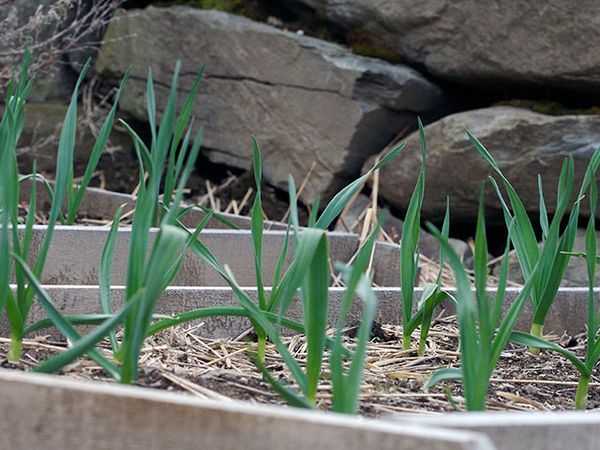
Watering
The grown garlic is recommended to be watered in the autumn, if it does not rain for too long. But seedlings do not require frequent watering. The soil should not dry out, so if the top ball of the soil is already covered with a crust, water the seedlings. Moderation is of paramount importance here. Homemade garlic seeds will root much faster and better and prepare for cold weather if you water the ground from time to time.
Fertilizers
It is recommended to carry out top dressing for the first time 2-3 weeks before planting garlic in the ground. To do this, you need to add wood or straw ash, humus, as well as potassium sulfate and superphosphate to the soil. In the process of planting the bulbs in the ground, you can fill the beds with wood ash or add a small amount of humus there. In this case, after wintering, the development of garlic will be much more active.


Varieties of garlic
Spring garlic
This species is planted in open ground in early spring and harvested in early autumn. The heads of spring garlic are medium-sized, but they are perfectly stored until the next fresh harvest without losing their properties. In addition, the plants do not form arrows, and the bulbs themselves consist of small inner teeth and larger outer ones. Large slices are selected for seed.
Popular varieties: Yelenovsky, Gulliver, Victorio, Moskovsky.
Winter varieties
The difference with summer varieties lies in the planting technology and the size of the bulbs - they are noticeably larger in winter garlic. Used in everyday food and culinary production, poorly stored. Arrowhead varieties ripen earlier and yield a harvest at the beginning of summer, but require additional care.
Popular names in Russia are Zubrenok, Alkor, Lyubasha, Lekar, German and others.
Cleaning one-toothed
Garlic (one-toothed) is harvested in late July or early August. The resulting crop can be used like regular garlic. Harvested in the same terms as for regular garlic.
Single teeth are mainly used as planting material. From them, the next year, normal garlic heads grow, in which at least four cloves will be formed.
Based on long-term observations, it has been established that it is desirable to renew at least one third of the planting material of winter garlic annually. For this, during planting, the cloves are carefully sorted and rejected. It is corrected when planting by adding one-toothed teeth to the seeding.
Planting winter varieties of garlic
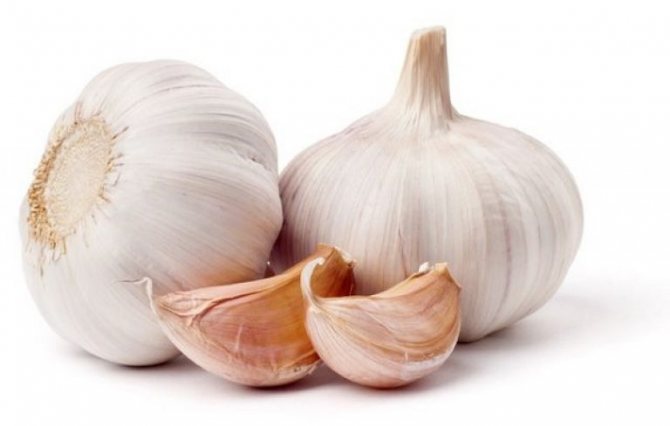

Medium late, shooted, onion with 8-11 teeth, very spicy taste. Resistant to diseases and pests, winter-hardy.
Mid-season, does not form an arrow. 16-18 cloves in an onion. The taste is semi-sharp.
In central Russia, the optimal time for placing seeds in the ground is considered to be the end of September - early October. If planted earlier, the cloves will sprout and give shoots, which will freeze and will not sprout in the spring. With late planting, they will not have time to root and will slowly sprout.
For planting under the snow, the slices are dried, then they are not afraid of any frosts.
The standard distance between rows is 25 cm, between plants is 8 cm.The depth of burial is at least 10-12 cm, so that the germinating roots do not push the seed to the surface before the onset of cold weather. Planting among other garden plants gives good results. This compaction does not affect yield in any way. Dry soil can be watered once before the onset of cold weather.
More details here: Planting garlic in the fall before winter. Winter garlic varieties
For spring sowing, it is desirable to have a prepared bed. The topsoil thaws before anyone else and is already suitable for planting garlic seeds, without waiting for the soil to thaw to its full depth. Planting early is the key to a great future harvest.
There are several options for planting garlic:
- Rows with an interval between plants of 10 cm and a distance of 20 cm to the next groove;
- Using the square method with a mesh size of 15 by 15 cm;
- Two-layer planting in one hole, when the first clove is deepened by 15 cm, and the second by 8 cm;
- Two-layer planting in squares - the teeth of the lower layer are located in the center of the squares formed by the upper row of seeds.
Such nesting schemes help to get a harvest throughout the season, and the yield is 1.5-2 times higher than the standard one.
When do you prefer to plant garlic?
SpringAutumn
Step-by-step instructions for planting
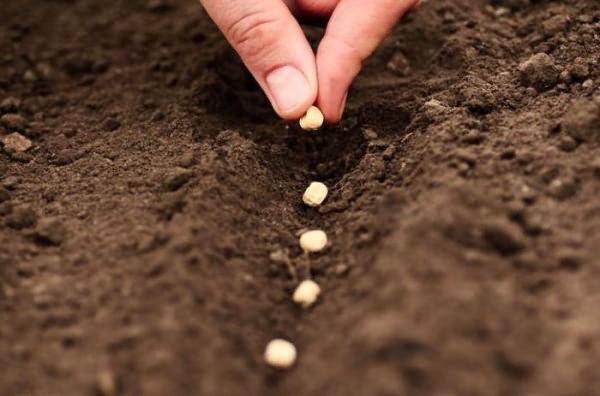

- Make grooves on the beds, 5 cm deep at a distance of 40 cm from each other.
- The bulbs are placed at a distance of 1-2 cm from one another.
- Cover the grooves with soil. If a harsh winter is coming, it is necessary to mulch the beds with a layer of sawdust 2-3 cm thick.
- When spring comes, the layer of sawdust will need to be removed.
Into the winter
The most popular way of planting garlic seeds is winter planting (sowing winter garlic). It differs from the spring planting in that the beds must be mulched with sawdust or peat so that the planted seeds do not freeze.
In the spring
Spring planting differs in that in early spring the ground is not yet sufficiently warmed up, and it will be difficult to dig it. Therefore, the beds for spring planting of garlic are usually prepared in the fall.
Non-stop method
This method differs from the previous ones in that garlic seeds are sown in spring. By October, single-toothed bulbs, consisting of single cloves, ripen.
One-teeth do not dig out, but leave to winter in a garden bed, which is well insulated with sawdust or fallen leaves. By mid-June, when the one-toothed bulbs have turned into whole large bulbs, a quality crop can be harvested.
Seed preparation
It is important to know that any garlic is sensitive to soil acidity. This plant prefers normal or alkaline soils, so it is not recommended to apply fresh organic fertilizers before planting.
The landing site should be in a dry and well-lit area. In the shade, the plant will go into the arrow, and the bulbs will remain underdeveloped. The optimal soil will be loamy with a large amount of organic matter (peat, humus, compost), which has good moisture capacity.
For garlic, the following crop rotation rules are observed:
- Grows well after zucchini, potatoes, cabbage;
- Suitable for the neighborhood with bushes of raspberries, currants, gooseberries, strawberries;
- It is not recommended to plant after onions, carrots, cucumbers and tomatoes;
- The maximum period for planting garlic in one place is 2 years in a row, the next planting at this place is not earlier than in 4 years.
Preparation of the land begins in the fall, when the garden bed is cleared of weeds and fertilized with compost, leaves, and overripe manure. To reduce acidity, lime, chalk solution or dolomite flour are added.
In the spring, everything is dug up and minerals are introduced in the form of superphosphate - 30g / m2 and potassium salt or urea at 20g / m2.
You can buy ready-made planting teeth at the store, but it is better to do it yourself. For this, the best bulbs from last year's harvest are selected for each type separately.The main selection criteria are considered to be the large size of the slices, their cleanliness and the absence of mold on the surface. Even one infected clove in the bulb can cause infection for everyone else. Until planting, the heads are not divided into slices, but stored in a dark and dry place.
Peeled teeth are soaked just before planting in a weak solution of potassium permanganate or phytophtorine to prevent the development of fungal diseases.
Another popular way to get seeds is from arrowheads with inflorescences. The best plants are selected and the arrows are left on them until they are fully ripe. An onion (air bulb) is considered ready, which has acquired a characteristic color and has been freed from the protective film. Large and healthy bulbs are plucked onto the seeds. This scheme is for two years. In the first year, one clove is received, and in the second a full-fledged onion.
The advantages of this method:
- The planting material has no contact with the soil and is therefore practically sterile;
- A large number of quality cloves from the heads of garlic are not consumed.
A feature of any variety of garlic is the need for long-term stratification - finding planting material in cold conditions. Therefore, winter garlic is planted just before the onset of cold weather, and spring garlic in cold soil immediately after the snow cover disappears. This planting technology favors the development of a healthy plant and a bountiful harvest.
The best predecessors are crops that vacate the field early, under which organic fertilizers are applied: cucumbers, zucchini, early cabbage, lettuce, legumes. In other words, plant the garlic in the soil where the organic was introduced a year ago, no later. He does not like the soil freshly fertilized with manure - the feathers will be lush, the heads are small and loose. In addition, excess fertilizer will contribute to the development of fungal diseases.
Do not plant garlic again in the same place. And after the onion, it is not recommended to plant it, because they are affected by the same pests, diseases. But garlic itself is a good predecessor for all crops, of course, except for onions.
Getting seeds from arrows
To obtain high-quality seed, you need to wait for the winter garlic to release arrows, this usually happens towards the end of May. After June 20, the arrows should be shortened, leaving a few of the largest and strongest seeds for ripening.
It is necessary to cut off the arrows with seeds at the end of July, when the shell covering the bulbs cracks. We must try not to miss this moment, and not to overexpose them, as the seeds can fall into the soil.
The collected bulbs do not need to be separated, they should be stored whole, wrapped in dry gauze treated with potassium permanganate. When the stems are well dry, the bulbs can be separated, dried and stored in a dry place until planting.
Garlic planting care, feeding
Seedlings of plants need regular care and respect for them. This applies to watering, weeding, fertilizing.


It is no secret that garlic loves moist soil and abundant watering, especially during the period of sprouting. At this time, he needs regular watering in the amount of 10-12 liters per square meter.
As the bulbs grow, the intensity of watering is reduced, and from August to harvest, it is completely stopped. This reduces the risk of decay and spoilage of ready-made garlic heads in the ground.
They begin to weed with the appearance of the first shoots. Not only weeds are removed, but also excess shoots of garlic, which interfere with the full formation of the main bulbs. Simultaneously with weeding the beds, they are loosened (it is recommended to loosen the soil after rains).
Breaking the arrows begins with their growth up to 15-20 cm, if it is not planned to obtain bulbs for seeds. The arrows should be broken or cut closer to the bulb. The broken shoot will continue to grow, taking a lot of nutrients from the root system. This operation is performed regularly.
How to grow garlic from seeds is described in detail in our other article: Growing garlic from bulbs (seeds)
Fertilizing the soil
The introduction of mineral and organic substances greatly affects the yield of garlic. It is important to accurately observe the dosage and time of fertilization. Preference is given to fertilizers containing phosphorus and potassium: superphosphate, potassium sulfate, ammonium nitrate, urea, ammophoska.
These fertilizers are applied 3 times per season - at the beginning of planting, after a month, when a small bulb is formed.
Organic fertilizers are applied with the appearance of the first leaves. Mullein solution is considered the best in composition. It is rich in nitrogen and harmless to plants and humans. Poultry and other droppings are used carefully, bringing them in a rotten form or weak solutions. A large amount of nitrogen is needed only at the initial stage of growth.
Read more in our other article: How to feed garlic? In the spring, in the fall, before planting
One of the secrets of growing garlic is feeding.
In early spring, after the snow melts, as soon as the first warm days come, it would be nice to feed the crops with nitrogen fertilizers, for example, urea (1 tablespoon / 10 l of water). For 1 m2, approximately 5 liters of mortar should be consumed.
In April, when the seedlings grow up, feeding is carried out twice, for example, this is the middle and end of April. The first feeding should contain more nitrogen. Its composition may be as follows: half a liter of chicken manure 1 tbsp. spoon nitroammophoska in a bucket (10 liters) of water. The second feeding should contain more phosphorus and potassium. The composition is as follows: 1 tbsp. spoon of double superphosphate 1 tbsp. spoon of potassium sulfate 1 teaspoon of urea in a bucket (10 L) of water. We also consume about 5 liters of mortar per 1 m2.


Be sure to loosen the soil between the rows after feeding the next day, loosen it again after a week and a half, if the soil is dry, water it. Garlic loves loose soil without weeds - oxygen must be supplied to the roots and bulbs of the plant, so loosen the soil between the rows after each watering or after rain. By the way, if there is no rain, then watering should be carried out at least weekly. Water abundantly - 12-15 liters per m2.
Mulching the row spacings can facilitate the work of the gardener. Mulch will retain moisture, and the soil under the mulch always remains loose.
In order for you to grow large heads, the arrows must be broken out in time. Try to break or cut them, and do not pull up - this way you can accidentally pull out the entire bulb or damage its root system. Break the arrows when they have reached a length of 12-15 cm, the breakout point should be as close to the rosette of leaves as possible. If you break it in a shorter length, then it will continue to grow - you will not get a large head.
Breaking out arrows is a special agricultural technique that allows not only to increase the size of the head, but also accelerates their maturation.
By the way, do not throw out the broken arrows - they can be used when preserving blanks, as a seasoning for food.
For example, add finely chopped garlic arrows to boiled potatoes, after you've drained the water and slightly dried them. Add butter or sour cream, stir and serve. Once upon a time, long ago, I read this recipe - it was called "Phytoncid potato". Since then, it has been one of our family's favorite dishes.
Finely chopped arrows can be added to boiled hot pasta or noodles - this is also tasty, healthy, especially in spring, when vitamins are so lacking.
Autumn planting of bulbs
In the fall, sowing of seed is carried out at the same time as planting winter garlic. For Central Russia, it is recommended to carry out similar work from late September to mid-October.
Soil preparation
Before planting, you need to prepare the beds, where the seed will germinate in the future. Primary requirements:
- Desirable precursors: legumes, tomatoes, peppers, eggplants, carrots;
- unwanted precursors: onions, garlic, cabbage, cucumbers, zucchini, pumpkins, potatoes;
- loose soil with a neutral reaction, pH = 5.0 ... 6.0;
- the depth of the fertile layer is not less than 18 cm, the average size of soil particles is 10 ... 20 mm;
- the presence of humus, the presence of high-moor peat is allowed.
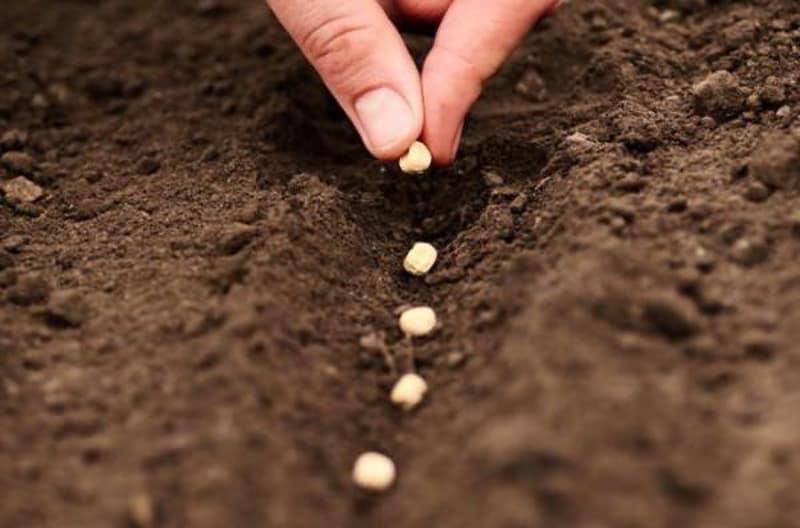

The sequence of preparing the beds.
- Deep loosening with soil mills or the Mole ripper.
- Adding gypsum (at pH = 6.0 ... 7.0) or hydrated lime (at pH = 4.0 ... 4.5), for each square meter at least 30 g.
- Boric acid application, 10 ... 12 g / m2;
- Urea addition, 25 ... 35 g / m2;
- Introduction of superphosphate, 20 ... 25 g / m2;
- Potassium nitrate addition, 8 ... 12 g / m2;
- Mix all mineral additives with a rake.
The seeds can be planted in the strawberry garden. They also conduct training there.
- In the middle of the ridge, as well as along the edges, deep loosening is performed, using a garden pitchfork.
- Add the mineral supplements shown above.
- Stirred, planting can be done in a week.
Planting bulbs
Before planting, seed material is prepared. It is soaked for 10 ... 15 minutes in a solution of potassium permanganate (light pink solution).
It is useful to process in a solution of heteroauxin: the roots are better formed. The tablet is diluted in 1 liter of water. Then the bulbs are immersed for 15 ... 20 minutes.
- For planting at a distance of 12 ... 15 cm, create small grooves with a depth of 4.0 ... 4.5 cm.
- Spill with a solution of potassium permanganate. Some vegetable growers recommend spilling boiling water from a kettle to finally get rid of the infection.
- Spread the seeds at a distance of 8 cm.
- Then sprinkle on top with peat, humus or loose soil.
Landing in the holes is also possible. For this, markers are used with pegs 4 cm long and 2 ... 3 cm in diameter. The holes are made with the markers, and then the bulbs are laid out in the holes. Then sprinkle or rake the soil layer.
For the winter, the garden bed is covered. Straw (4 ... 8 cm) or hay (up to 15 cm) serves as a good cover. Some gardeners use a covering material (agrospam). They are fixed with staples made of steel wire.
Diseases and pests of garlic
Plants are susceptible to fungal diseases that can be airborne or in untreated soil.
Such diseases are:
- Bacterial rot;
- Black mold;
- Peronosporosis;
- Fusarium.
Treatment of affected plants is carried out by spraying with fungicides or Bordeaux liquid. After harvesting, the stems from these plants are burned, and the garden bed is treated with the same preparations. It is advisable to change the cultivated crop, for example, sow with carrots or potatoes.
Among parasitic insects, stem nematode, onion fly and garlic mite inflict great damage. They affect plants and fruits in the garden and during storage. They destroy pests with insecticidal preparations (intavir), and thorough cleaning of the beds at the beginning of the season and deep digging helps to prevent their appearance.
Read more in our other article: Why does garlic turn yellow in spring: what to do? Review of causes, pests and control methods
Harvesting
Garlic is harvested when its leaves begin to turn yellow, usually closer to August. You can dig up one onion for a sample and examine it - it must be developed and dense. Gardeners believe that it is better to harvest early than to overexpose it in the ground. Unripe bulbs may well ripen at home.
The bulbs should be dug out with a pitchfork, the leaves should not be torn off, the arrows should be cut off. The dug out bulbs are laid out to dry for several hours in the sun. When the leaves are dry, they can be shortened slightly and braided for storage.
If it is necessary to dig up one-toothed teeth, as a future seed, then they are harvested when the tips of the leaves have just turned yellow, but not later. One-toothed teeth should not be overexposed in the soil, the bulb may deepen, and this leads to a reduction in the yield in the future.
After collecting, the one-tooth is dried well, then the roots and stems are removed, sorted by size and stored in a dry, dark, well-ventilated room.
When to collect garlic bulbs for seeds


The ripening time of the air bulb and the head is the same. In August, the thin skin on the seed pod begins to crack, and the feathers turn yellow and dry out. These two signs tell the gardener: it's time to empty the garden.
Step-by-step recommendations for collecting and storing seed cloves:
- In order not to scatter the bulbs, the air is wrapped with gauze or a nylon stocking is put on the arrow. Plucking without such "protection" is not worth it: the teeth are ripe, and from a sudden movement they can crumble.
- Cut off the shoot with a bulb 10-15 cm below the base.
- Tied in bundles or braided.
- Dry in a cool dry room with natural ventilation.
- They are planted according to the usual rules for winter garlic.
Advantages and disadvantages of this method
Garlic seeds ripen in bulbs, which are located above the leaves of the culture. This breeding method has advantages and disadvantages that you should be aware of before starting planting.
The advantages of such a reproduction of culture include:
- the seeds are rarely exposed to the appearance of diseases, so there is no risk that there will be no seedlings. If all the features of sowing are observed, the product turns out to be fragrant and does not lose its qualities even after long storage;
- with the help of several bulbs, you can get a harvest in large volume;
- if the chives are damaged, the use of seeds allows you not to lose the variety;
- using such planting material, large heads can grow;
- planting seeds is simple, it is enough to sow in the ground;
- properly harvested planting material gives a high level of germination.
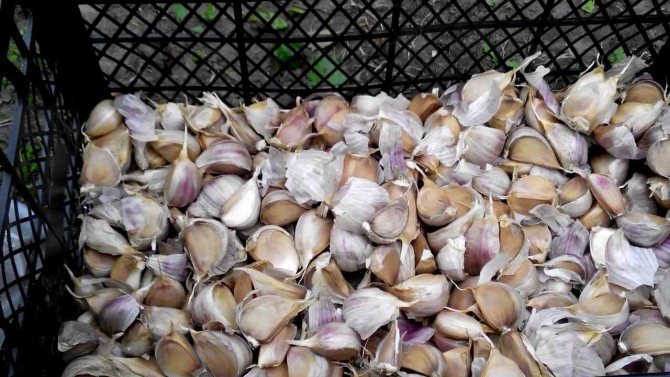

Benefits of using seeds
However, like any method of propagation of cultivated plants, this method has the following disadvantages:
- you can get a big harvest only after 2 years;
- in severe frosts, seeds can be damaged and germinate poorly.
Also, in some cases, under dry weather conditions, the bulbs can dry out, which reduces the percentage of germination. Planting material can deteriorate if the bulbs are not collected correctly. Unripe grains are not suitable for crop propagation.
Important! One of the features of the bulb is the large number of grains inside. Correctly harvested seeds can be stored for a year without degrading their performance. Seedlings give both large and small grains.
How to grow and collect bulbs
There is nothing difficult in growing bulbs. Moreover, you don't even need to do something on purpose, because they grow on their own on garlic arrows... It is much more important to correctly collect the seeds.
To do this, you must first of all wait for the moment when the protective "capsule" bursts and the seeds are outside.
This moment comes around the middle of July, less often at the end. For spring garlic, the timing is slightly shifted, and the collection should be carried out towards the end of August.
Thereafter, seeds must be carefully cut and stored until the moment of landing.
There are some varieties of garlic that do not develop arrows. Accordingly, it will not be possible to collect seeds from such species, so this must be taken into account.
By the way, sometimes it happens that the bulb does not burst, and some gardeners think that the seeds have not ripened there yet, however, this is not so.
In this situation, you should pay attention to the leaves of garlic., namely, their color. If yellowness begins to appear, then you can collect, but if not, then it is better to wait a little.
When to collect garlic puff and how to store it:
How and where to store sevok
Storing cut seeds is no big deal. Primarily, they must be placed in some box or small cardboard box and brought into the barn or any other room, the main thing is that there is a temperature of at least 18-20 degrees Celsius.
Approximately 1.5-2 months before sowing, the seeds should be transferred to a cooler place, with a temperature of 5-8 degrees Celsius.
This is necessary in order so that the planting material dries well and hardens and during the first sharp frosts it did not deteriorate in the ground. That's in general, that's all.
Pros and cons of the decision to plant one-tooth
The planting of a one-toothed tooth has more pluses than minuses, since the seed:
- tolerates spring frosts and severe frosts well;
- germinates quickly (the cloves do not need to be placed strictly vertically in the hole, the sprouted roots pull them down).
Note! Germinated from seedlings, one-clove garlic grows large, of the same size, retaining all the characteristics of the variety.
The negative sides of planting sevka include:
- high cost of seeds;
- the duration of the growing process.
Bulbs are obtained from the seeds, they are planted in the ground, a set is grown and it is already used to obtain large heads of garlic that retain the varietal superiority.
What varieties can be sown in this way
All types of garlic, throwing out arrows, multiply by sowing. Popular among vegetable growers and buyers are such varieties as:
- Alkor is a winter plant with a bright pronounced pleasant aroma and a small head, weighing up to 40 g;
- Promin is a winter, early ripening variety with a pungent taste;
- Sofievsky - has a whitish or light purple head with dark veins, weighs up to 105 g;
- Herman is a mid-season variety, the heads weigh about 45-50 g each.
For your information! One of the best varieties for seed selection is Lyubasha. The garlic is early ripening, tolerates severe frosts and droughts. Its weight reaches 120 g. The heads are stored all winter. When sowing the one-toothed, it is possible to collect a colossal harvest of Lyubasha. It can be grown in temperate climates and in the south.

